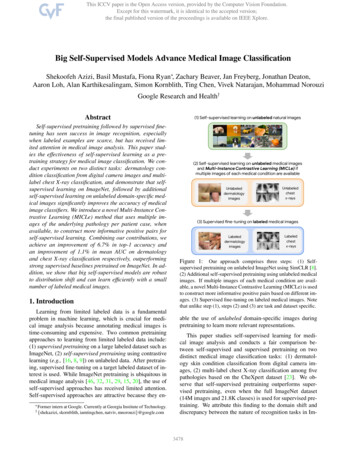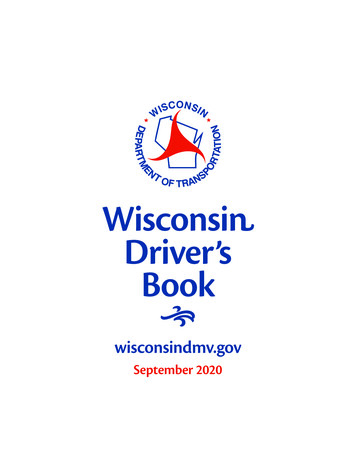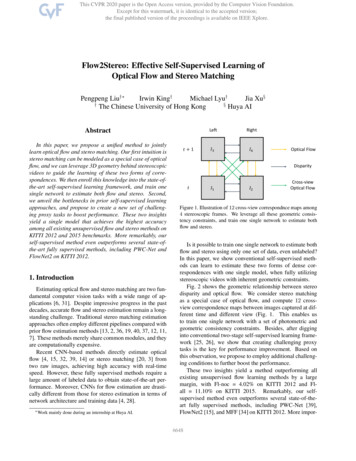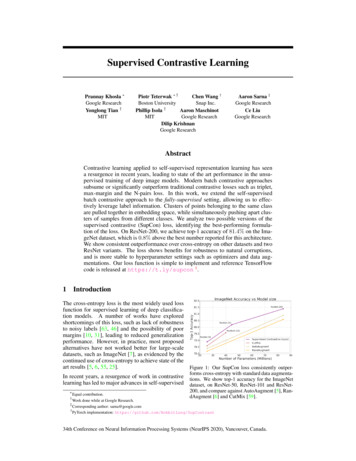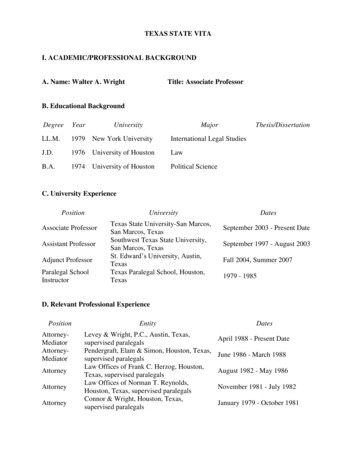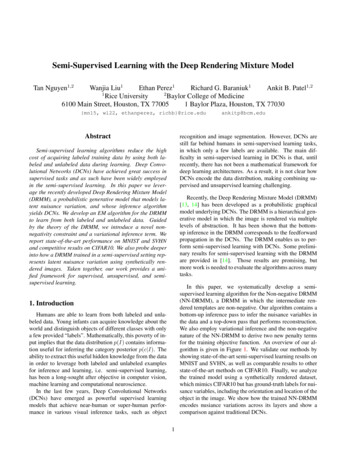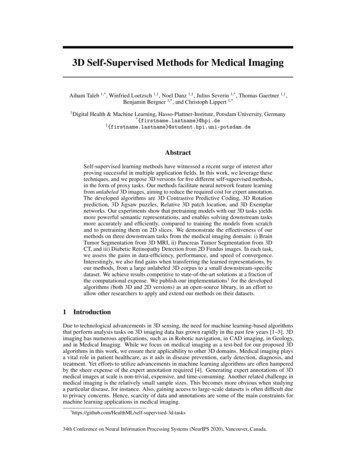
Transcription
3D Self-Supervised Methods for Medical ImagingAiham Taleb 1,* , Winfried Loetzsch 1,† , Noel Danz 1,† , Julius Severin 1,* , Thomas Gaertner 1,† ,Benjamin Bergner 1,* , and Christoph Lippert 1,*1Digital Health & Machine Learning, Hasso-Plattner-Institute, Potsdam University, pervised learning methods have witnessed a recent surge of interest afterproving successful in multiple application fields. In this work, we leverage thesetechniques, and we propose 3D versions for five different self-supervised methods,in the form of proxy tasks. Our methods facilitate neural network feature learningfrom unlabeled 3D images, aiming to reduce the required cost for expert annotation.The developed algorithms are 3D Contrastive Predictive Coding, 3D Rotationprediction, 3D Jigsaw puzzles, Relative 3D patch location, and 3D Exemplarnetworks. Our experiments show that pretraining models with our 3D tasks yieldsmore powerful semantic representations, and enables solving downstream tasksmore accurately and efficiently, compared to training the models from scratchand to pretraining them on 2D slices. We demonstrate the effectiveness of ourmethods on three downstream tasks from the medical imaging domain: i) BrainTumor Segmentation from 3D MRI, ii) Pancreas Tumor Segmentation from 3DCT, and iii) Diabetic Retinopathy Detection from 2D Fundus images. In each task,we assess the gains in data-efficiency, performance, and speed of convergence.Interestingly, we also find gains when transferring the learned representations, byour methods, from a large unlabeled 3D corpus to a small downstream-specificdataset. We achieve results competitive to state-of-the-art solutions at a fraction ofthe computational expense. We publish our implementations1 for the developedalgorithms (both 3D and 2D versions) as an open-source library, in an effort toallow other researchers to apply and extend our methods on their datasets.1IntroductionDue to technological advancements in 3D sensing, the need for machine learning-based algorithmsthat perform analysis tasks on 3D imaging data has grown rapidly in the past few years [1–3]. 3Dimaging has numerous applications, such as in Robotic navigation, in CAD imaging, in Geology,and in Medical Imaging. While we focus on medical imaging as a test-bed for our proposed 3Dalgorithms in this work, we ensure their applicability to other 3D domains. Medical imaging playsa vital role in patient healthcare, as it aids in disease prevention, early detection, diagnosis, andtreatment. Yet efforts to utilize advancements in machine learning algorithms are often hamperedby the sheer expense of the expert annotation required [4]. Generating expert annotations of 3Dmedical images at scale is non-trivial, expensive, and time-consuming. Another related challenge inmedical imaging is the relatively small sample sizes. This becomes more obvious when studyinga particular disease, for instance. Also, gaining access to large-scale datasets is often difficult dueto privacy concerns. Hence, scarcity of data and annotations are some of the main constraints formachine learning applications in medical ed-3d-tasks34th Conference on Neural Information Processing Systems (NeurIPS 2020), Vancouver, Canada.
Several efforts have attempted to address these challenges, as they are common to other applicationfields of deep learning. A widely used technique is transfer learning, which aims to reuse the featuresof already trained neural networks on different, but related, target tasks. A common example isadapting the features from networks trained on ImageNet, which can be reused for other visual tasks,e.g. semantic segmentation. To some extent, transfer learning has made it easier to solve tasks withlimited number of samples. However, as mentioned before, the medical domain is supervision-starved.Despite attempts to leverage ImageNet [5] features in the medical context [6–9], the difference inthe distributions of natural and medical images is significant, i.e. generalizing across these domainsis questionable and can suffer from dataset bias [10]. Recent analysis [11] has also found thatsuch transfer learning offers limited performance gains, relative to the computational costs it incurs.Consequently, it is necessary to find better solutions for the aforementioned challenges.A viable alternative is to employ self-supervised (unsupervised) methods, which proved successfulin multiple domains recently. In these approaches, the supervisory signals are derived from thedata. In general, we withhold some part of the data, and train the network to predict it. Thisprediction task defines a proxy loss, which encourages the model to learn semantic representationsabout the concepts in the data. Subsequently, this facilitates data-efficient fine-tuning on superviseddownstream tasks, reducing significantly the burden of manual annotation. Despite the surge ofinterest in the machine learning community in self-supervised methods, only little work has beendone to adopt these methods in the medical imaging domain. We believe that self-supervised learningis directly applicable in the medical context, and can offer cheaper solutions for the challenges facedby conventional supervised methods. Unlabelled medical images carry valuable information aboutorgan structures, and self-supervision enables the models to derive notions about these structureswith no additional annotation cost.A particular aspect of most medical images, which received little attention by previous self-supervisedmethods, is their 3D nature [12]. The common paradigm is to cast 3D imaging tasks in 2D, by extracting slices along an arbitrary axis, e.g. the axial dimension. However, such tasks can substantiallybenefit from the full 3D spatial context, thus capturing rich anatomical information. We believe thatrelying on the 2D context to derive data representations from 3D images, in general, is a suboptimalsolution, which compromises the performance on downstream tasks.Our contributions. As a result, in this work, we propose five self-supervised tasks that utilize thefull 3D spatial context, aiming to better adopt self-supervision in 3D imaging. The proposed tasksare: 3D Contrastive Predictive Coding, 3D Rotation prediction, 3D Jigsaw puzzles, Relative 3Dpatch location, and 3D Exemplar networks. These algorithms are inspired by their successful 2Dcounterparts, and to the best of our knowledge, most of these methods have never been extended tothe 3D context, let alone applied to the medical domain. Several computational and methodologicalchallenges arise when designing self-supervised tasks in 3D, due to the increased data dimensionality,which we address in our methods to ensure their efficiency. We perform extensive experiments usingfour datasets in three different downstream tasks, and we show that our 3D tasks result in rich datarepresentations that improve data-efficiency and performance on three different downstream tasks.Finally, we publish the implementations of our 3D tasks, and also of their 2D versions, in order toallow other researchers to evaluate these methods on other imaging datasets.2Related workIn general, unsupervised representation learning can be formulated as learning an embedding space,in which data samples that are semantically similar are closer, and those that are different are farapart. The self-supervised family constructs such a representation space by creating a supervisedproxy task from the data itself. Then, the embeddings that solve the proxy task will also be useful forother real-world downstream tasks. Several methods in this line of research have been developedrecently, and they found applications in numerous fields [13]. In this work, we focus on methods thatoperate on images only.Self-supervised methods differ in their core building block, i.e. the proxy task used to learn representations from unlabelled input data. A commonly used supervision source for proxy tasks is the spatialcontext from images, which was first inspired by the skip-gram Word2Vec [14] algorithm. This ideawas generalized to images in [15], in which a visual representation is learned by predicting the position of an image patch relative to another. A similar work extended this patch-based approach to solve2
Jigsaw Puzzles [16]. Other works have used different supervision sources, such as image colors [17],clustering [18], image rotation prediction [19], object saliency [20], and image reconstruction [21].In recent works, Contrastive Predictive Coding (CPC) approaches [22, 23] advanced the results ofself-supervised methods on multiple imaging benchmarks [24, 25]. These methods utilize the idea ofcontrastive learning in the latent space, similar to Noise Contrastive Estimation [26]. In 2D images,the model has to predict the latent representation for next (adjacent) image patches. Our work followsthis line of research in the above works, however, our methods utilize the full 3D context.While videos are rich with more types of supervisory signals [27–31], we discuss here a subset ofthese works that utilize 3D-CNNs to process input videos. In this context, 3D-CNNs are employedto simultaneously extract spatial features from each frame, and temporal features across multipleframes, which are typically stacked along the 3rd (depth) dimension. The idea of exploiting 3Dconvolutions for videos was proposed in [32] for human action recognition, and was later extended toother applications [13]. In self-supervised learning, however, the number of pretext tasks that exploitthis technique is limited. Kim et al. [33] proposed a task that extracts cubic puzzles of 2 2 1,meaning that the 3rd dimension is not actually utilized in puzzle creation. Jing et al. [34] extended therotation prediction task [19] to videos, by simply stacking video frames along the depth dimension,however, this dimension is not employed in the design of their task as only spatial rotations areconsidered. Han et al. proposed a dense encoding of spatio-temporal frame blocks to predict futurescene representations recurrently, in conjunction with a curriculum training scheme to extend thepredicted future. Similarly, the depth dimension is not employed in this task. On the other hand, inour more general versions of 3D Jigsaw puzzles and 3D Rotation prediction, respectively, we exploitthe depth (3rd ) dimension in the design of our tasks. For instance, we solve larger 3D puzzles up to3 3 3, and we also predict more rotations along all axes in the 3D space. Futhermore, in our 3DContrastive Predictive Coding task, we predict patch representations along all 3 dimensions, scanninginput volumes in a manner that resembles a pyramid. In general, we believe the different nature ofthe data, 3D volumetric scans vs. stacked video frames, influences the design of proxy tasks, i.e. thedepth dimension has an actual semantic meaning in volumetric scans. Hence, we consider the whole3D context when designing all of our methods, aiming to learn valuable anatomical information fromunlabeled 3D volumetric scans.In the medical context, self-supervision has found use-cases in diverse applications such as depthestimation in monocular endoscopy [35], robotic surgery [36], medical image registration [37], bodypart recognition [38], in disc degeneration using spinal MRIs [39], in cardiac image segmentation [40],body part regression for slice ordering [41], and medical instrument segmentation [42]. Spitzer etal. [43] sample 2D patches from a 3D brain, and predict the distance between these patches asa supervision signal. Tajbakhsh et al. [44] use orientation prediction from medical images as aproxy task. There are multiple other examples of self-supervised methods for medical imaging, suchas [45–49]. While these attempts are a step forward for self-supervised learning in medical imaging,they have some limitations. First, as opposed to our work, many of these works make assumptionsabout input data, resulting in engineered solutions that hardly generalize to other target tasks. Second,none of the above works capture the complete spatial context available in 3-dimensional scans, i.e.they only operate on 2D/2.5D spatial context. In a more related work, Zhou et al. [50] extendedimage reconstruction techniques from 2D to 3D, and implemented multiple self-supervised tasksbased on image-reconstruction. Zhuang et al. [51] and Zhu et al. [52] developed a proxy task thatsolves small 3D jigsaw puzzles. Their proposed puzzles were only limited to 2 2 2 of puzzlecomplexity. Our version of 3D Jigsaw puzzles is able to efficiently solve larger puzzles, e.g. 3 3 3,and outperforms their method’s results on the downstream task of Brain tumor segmentation. In thispaper, we continue this line of work, and develop five different algorithms for 3D data, whose natureand performance can accommodate more types of target medical applications.3Self-Supervised MethodsIn this section, we discuss the formulations of our 3D self-supervised pretext tasks, all of which learndata representations from unlabeled samples (3D images), hence requiring no manual annotationeffort in the self-supervised pretraining stage. Each task results in a pretrained encoder model gencthat can be fine-tuned in various downstream tasks, subsequently.3
Input{xi-2,v,w}v [j-2,j 2], w [k-2,k 2]ci,j,k{zu,v,w}u i,v,w{xi-1,v,w}v [j-1,j 1], w [k-1,k 1]xi,j,k𝓛CPCgcxtgencxi 1,j,kxi 2,j,kzi 1,j,k , zi putyq nczShared𝓛RotgencAngle 0 on axis zx i xWeightszi gencShared𝓛ExeWeightsyx i-zi -genc(e)(d)Figure 1: (a) 3D-CPC: each input image is split into 3D patches, and the latent representationszi 1,j,k , zi 2,j,k of next patches xi 1,j,k , xi 2,j,k (shown in green) are predicted using the contextvector ci,j,k . The considered context is the current patch xi,j,k (shown in orange), plus the abovepatches that form an inverted pyramid (shown in blue). (b) 3D-RPL: assuming a 3D grid of 27patches (3 3 3), the model is trained to predict the location yq of the query patch xq (shown inred), relative to the central patch xc (whose location is 13). (c) 3D-Jig: by predicting the permutationapplied to the 3D image when creating a 3 3 3 puzzle, we are able to reconstruct the scrambledinput. (d) 3D-Rot: the network is trained to predict the rotation degree (out of the 10 possible degrees)applied on input scans. (e) 3D-Exe: the network is trained with a triplet loss, which drives positive samples closer in the embedding space (x i to xi ), and the negative samples (xi ) farther apart.3.13D Contrastive Predictive Coding (3D-CPC)Following the contrastive learning idea, first proposed in [26], this universal unsupervised techniquepredicts the latent space for future (next or adjacent) samples. Recently, CPC found success in multipleapplication fields, e.g. its 1D version in audio signals [22], and its 2D versions in images [22, 23], andwas able to bridge the gap between unsupervised and fully-supervised methods [24]. Our proposedCPC version generalizes this technique to 3D inputs, and defines a proxy task by cropping equallysized and overlapping 3D patches from each input scan. Then, the encoder model genc maps eachinput patch xi,j,k to its latent representation zi,j,k genc (xi,j,k ). Next, another model called thecontext network gcxt is used to summarize the latent vectors of the patches in the context of xi,j,k ,and produce its context vector ci,j,k gcxt ({zu,v,w }u i,v,w ), where {z} denotes a set of latentvectors. Finally, because ci,j,k captures the high level content of the context that corresponds toxi,j,k , it allows for predicting the latent representations of next (adjacent) patches zi l,j,k , wherel 0. This prediction task is cast as an N -way classification problem by utilizing the InfoNCEloss [22], which takes its name from its ability to maximize the mutual information between ci,j,kand zi l,j,k . Here, the classes are the latent representations {z} of the patches, among which is onepositive representation, and the rest N 1 are negative. Formally, the CPC loss can be written as4
follows:LCP C Xlog p(zi l,j,k ẑi l,j,k , {zn })i,j,k,l Xi,j,k,llogexp(ẑi l,j,k zi l,j,k )Pexp(ẑi l,j,k zi l,j,k ) exp( n ẑi l,j,k zn )(1)This loss corresponds to the categorical cross-entropy loss, which trains the model to recognizethe correct representation zi l,j,k among the list of negative representations {zn }. These negativesamples (3D patches) are chosen randomly from other locations in the input image. In practice,similar to the original NCE [26], this task is solved as a binary pairwise classification task.It is noteworthy that the proposed 3D-CPC task, illustrated in Fig. 1 (a), allows employing any networkarchitecture in the encoder genc and the context gcxt networks. In our experiments, we follow [22] inusing an autoregressive network using GRUs [53] for the context network gcxt , however, maskedconvolutions can be a valid alternative [54]. In terms of what the 3D context of each patch xi,j,kincludes, we follow the idea of an inverted pyramid neighborhood, which is inspired from [55, 56].This context is chosen based on a tradeoff between computational cost and performance. Too largecontexts (e.g. full surrounding of a patch) incur prohibitive computations and memory use. Theinverted-pyramid context was an optimal tradeoff.3.2Relative 3D patch location (3D-RPL)In this task, the spatial context in images is leveraged as a rich source of supervision, in order tolearn semantic representations of the data. First proposed by Doersch et al. [15] for 2D images, thistask inspired several works in self-supervision. In our 3D version, shown in Fig. 1 (b), we leveragethe full 3D spatial context in the design of our task. From each input 3D image, a 3D grid of Nnon-overlapping patches {xi }i {1,.,N } is sampled at random locations. Then, the patch xc in thecenter of the grid is used as a reference, and a query patch xq is selected from the surrounding N 1patches. Next, the location of xq relative to xc is used as the positive label yq . This casts the task asan N 1-way classification problem, in which the locations of the remaining grid patches are usedas the negative samples {yn }. Formally, the cross-entropy loss in this task is written as:LRP L KXlog p(yq ŷq , {yn })(2)k 1Where K is the number of queries extracted from all samples. In order to prevent the model fromsolving this task quickly by finding shortcut solutions, e.g. edge continuity, we follow [15] in leavingrandom gaps (jitter) between neighboring 3D patches. More details in Appendix.3.33D Jigsaw puzzle Solving (3D-Jig)Deriving a Jigsaw puzzle grid from an input image, be it in 2D or 3D, and solving it can be viewed asan extension to the above patch-based RPL task. In our 3D Jigsaw puzzle task, which is inspired byits 2D counterpart [16] and illustrated in Fig. 1 (c), the puzzles are formed by sampling an n n ngrid of 3D patches. Then, these patches are shuffled according to an arbitrary permutation, selectedfrom a set of predefined permutations. This set of permutations with size P is chosen out of then3 ! possible permutations, by following the Hamming distance based algorithm in [16] (details inAppendix), and each permutation is assigned an index yp {1, ., P }. Therefore, the problem is castas a P -way classification task, i.e., the model is trained to simply recognize the applied permutationindex p, allowing us to solve the 3D puzzles in an efficient manner. Formally, we minimize thecross-entropy loss of LJig (ypk , ŷpk ), where k {1, ., K} is an arbitrary 3D puzzle from the list ofextracted K puzzles. Similar to 3D-RPL, we use the trick of adding random jitter in 3D-Jig.3.43D Rotation prediction (3D-Rot)Originally proposed by Gidaris et al. [19], the rotation prediction task encourages the model tolearn visual representations by simply predicting the angle by which the input image is rotated. Theintuition behind this task is that for a model to successfully predict the angle of rotation, it needs5
to capture sufficient semantic information about the object in the input image. In our 3D Rotationprediction task, 3D input images are rotated randomly by a random degree r {1, ., R} out of theR considered degrees. In this task, for simplicity, we consider the multiples of 90 degrees (0 , 90 ,180 , 270 , along each axis of the 3D coordinate system (x, y, z). There are 4 possible rotationsper axis, amounting to 12 possible rotations. However, rotating input scans by 0 along the 3 axeswill produce 3 identical versions of the original scan, hence, we consider 10 rotation degrees instead.Therefore, in this setting, this proxy task can be solved as a 10-way classification problem. Then, themodel is tasked to predict the rotation degree (class), as shown in Fig. 1 (d). Formally, we minimizethe cross-entropy loss LRot (rk , r̂k ), where k {1, ., K} is an arbitrary rotated 3D image from thelist of K rotated images. It is noteworthy that we create multiple rotated versions for each 3D image.3.53D Exemplar networks (3D-Exe)The task of Exemplar networks, proposed by Dosovitskiy et al. [57], is one of the earliest methods inthe self-supervised family. To derive supervision labels, it relies on image augmentation techniques,i.e. transformations. Assuming a training set X {x1 , .xN }, and a set of K image transformationsT {T1 , .TK }, a new surrogate class Sxi is created by transforming each training sample xi X,where Sxi T xi {T xi T T }. Therefore, the task is cast as a regular classification task with across-entropy loss. However, this classification task becomes prohibitively expensive as the datasetsize grows larger, as the number of classes grows accordingly. Thus, in our proposed 3D version ofExemplar networks, shown in Fig. 1 (e), we employ a different mechanism that relies on the tripletloss instead [58]. Formally, assuming xi is a random training sample and zi is its correspondingembedding vector, x i is a transformed version of xi (seen as a positive example) with an embedding zi , and x i is a different sample from the dataset (seen as negative) with an embedding zi . Thetriplet loss is written as follows:LExe NT1 Xmax{0, D(zi , zi ) D(zi , zi ) α}NT i 1(3)where D(.) is a pairwise distance function, for which we use the L2 distance, following [59]. α isa margin (gap) that is enforced between positive and negative pairs, which we set to 1. The tripletloss enforces D(zi , zi ) D(zi , zi ), i.e. the transformed versions of the same sample (positivesamples) to come closer to each other in the learned embedding space, and farther away from other(negative) samples. Replacing the triplet loss with a contrastive loss [26] is possible in this method,and has been found to improve learned representations from natural images [24]. In addition, thelearned representations by Exemplar can be affected by the negatives sampling strategy. The simpleoption is to sample from within the same batch, however, it is also possible to sample from thewhole dataset. The latter choice is computationally more expensive, but is expected to improve thelearned representations, as it makes the task harder. It is noteworthy that we apply the following 3Dtransformations: random flipping along an arbitrary axis, random rotation along an arbitrary axis,random brightness and contrast, and random zooming.4Experimental ResultsIn this section, we present the evaluation results of our methods, which we assess the quality of theirlearned representations by fine-tuning them on three downstream tasks. In each task, we analyzethe obtained gains in data-efficiency, performance, and speed of convergence. In addition, each taskaims to demonstrate a certain use-case for our methods. We follow the commonly used evaluationprotocols for self-supervised methods in each of these tasks. The chosen tasks are: Brain Tumor Segmentation from 3D MRI (Subsection 4.1): in which we study the possibilityfor transfer learning from a different unlabeled 3D corpus, following [60]. Pancreas Tumor Segmentation from 3D CT (Subsection 4.2): to demonstrate how to use thesame unlabeled dataset, following the data-efficient evaluation protocol in [23]. Diabetic Retinopathy Detection from 2D Fundus Images (Subsection 4.3): to showcase ourimplementations for the 2D versions of our methods, following [23]. Here, we also evaluatepretraining on a different large corpus, then fine-tuning on the downstream dataset.6
We provide additional details about architectures, training procedures, the effect of augmentation inExemplar, and how we initialize decoders for segmentation tasks in the Appendix.4.1Brain Tumor Segmentation ResultsIn this task, we evaluate our methods by fine-tuning the learned representations on the MultimodalBrain Tumor Segmentation (BraTS) 2018 [61, 62] benchmark. Before that, we pretrain our modelson brain MRI data from the UK Biobank [63] (UKB) corpus, which contains roughly 22K 3D scans.Due to this large number of unlabeled scans, UKB is suitable for unsupervised pretraining. TheBraTS dataset contains annotated MRI scans for 285 training and 66 validation cases. We fine-tuneon BraTS’ training set, and evaluate on its validation set. Following the official BraTS challenge, wereport Dice scores for the Whole Tumor (WT), Tumor Core (TC), and Enhanced Tumor (ET) tasks.The Dice score (F1-Score) is twice the area of overlap between two segmentation masks divided bythe total number of pixels in both. In order to assess the quality of the learned representations by our3D proxy tasks, we compare to the following baselines: Training from scratch: the first sensible baseline for any self-supervised method, in general,is the same model trained on the downstream task when initialized from random weights.Comparing to this baseline provides insights about the benefits of self-supervised pretraining. Training on 2D slices: this baseline aims to quantitatively show how our proposal to operateon the 3D context benefits the learned representations, compared to 2D methods. Supervised pretraining: this baseline uses automatic segmentation labels from FSLFAST [64], which include masks for three brain tissues. Baselines from the BraTS challenge: we compare to the methods [65–68], which all use asingle model with an architecture similar to ours, i.e. 3D U-Net [69].Discussion. We first assess the gains in data-efficiency in this task. To quantify these gains, wemeasure the segmentation performance at different sample sizes. We randomly select subsets ofpatients at 10%, 25%, 50%, and 100% of the full dataset size, and we fine-tune our models onthese subsets. Here, we compare to the baselines listed above. As shown in Fig. 2, our 3D methodsoutperform the baseline model trained from scratch by a large margin when using few trainingsamples, and behaves similarly as the number of labeled samples increases. The low-data regimecase at 5% suggests the potential for generic unsupervised features, and highlights the huge gains indata-efficiency. Also, the proposed 3D versions considerably outperform their 2D counterparts, whichare trained on slices extracted from the 3D images. We also measure how our methods affect the finalbrain tumor segmentation performance, in Table 1. All our methods outperform the baseline trainedfrom scratch as well as their 2D counterparts, confirming the benefits of pretraining with our 3Dtasks on downstream performance. We also achieve comparable results to baselines from the BraTSchallenge, and we outperform these baselines in some cases, e.g. our 3D-RPL method outperformsall baselines in terms of ET and TC dice scores. Also, our model pretrained with 3D-Exemplar, withfewer downstream training epochs, matches the result of Isensee et al. [65] in terms of WT dicescore, which is one of the top results on the BraTS 2018 challenge. In comparison to the supervisedbaseline using automatic FAST labels, we find that our results are comparable, outperforming thisbaseline in some cases. Our results in this downstream task also demonstrate the generalizationability of our 3D tasks across different domains. This is result is significant, because medical datasetsare supervision-starved, e.g. images may be collected as part of clinical routine, but much fewer(high-quality) labels are produced, due to annotation costs.4.2Pancreas Tumor Segmentation ResultsIn this downstream task, we evaluate our models on 3D CT scans of Pancreas tumor from the medicaldecathlon benchmarks [70]. The Pancreas dataset contains annotated CT scans for 420 cases. Eachscan in this dataset contains 3 different classes: pancreas (class 1), tumor (class 2), and background(class 0). To measure the performance on this benchmark, two dice scores are computed for classes 1and 2. In this task, we pretrain using our proposed 3D tasks on pancreas scans without their annotationmasks. Then, we fine-tune the obtained models on subsets of annotated data to assess the gains inboth data-efficiency and performance. Finally, we also compare to the baseline model trained fromscratch and to 2D models, similar to the previous downstream task. Fig. 3 demonstrates the gains7
Table 1: BraTS segmentation resultsModel3D-From scratch3D larPopli et al. [66]Baid et al. [67]Chandra et al. [68]Isensee et al. jigsawrotationrplexemplarbaselinecpc 2Drotation 2Djigsaw 2Drpl 2Dexemplar 2DWT Dice .40102550Percentage of labelled images100Figure 2: Data-efficient segmentation resultsin BraTS. With less labeled data, the supervised baseline (brow
are: 3D Contrastive Predictive Coding, 3D Rotation prediction, 3D Jigsaw puzzles, Relative 3D patch location, and 3D Exemplar networks. These algorithms are inspired by their successful 2D counterparts, and to the best of our knowledge, most of these methods have never been extended to the 3D
